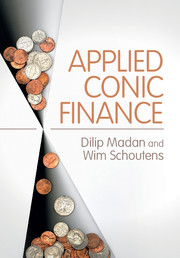Book contents
- Frontmatter
- Dedication
- Contents
- Preface
- Acknowledgements
- 1 Financial Mathematics Principles
- 2 Stochastic Processes and Financial Models
- 3 Numerical Techniques
- 4 Conic Finance
- 5 Conic Pricing
- 6 Applications of Conic Finance
- 7 Conic Portfolio Theory
- 8 Conic Hedging
- 9 Hedging Insurance Contracts
- 10 Option Positioning
- 11 Conic Trading
- References
- Index
2 - Stochastic Processes and Financial Models
Published online by Cambridge University Press: 27 October 2016
- Frontmatter
- Dedication
- Contents
- Preface
- Acknowledgements
- 1 Financial Mathematics Principles
- 2 Stochastic Processes and Financial Models
- 3 Numerical Techniques
- 4 Conic Finance
- 5 Conic Pricing
- 6 Applications of Conic Finance
- 7 Conic Portfolio Theory
- 8 Conic Hedging
- 9 Hedging Insurance Contracts
- 10 Option Positioning
- 11 Conic Trading
- References
- Index
Summary
Risk-Neutral Valuation
In financial engineering there are essentially two different worlds. The so-called real world (sometimes also referred to as the historical or physical world or P-world) and the pricing world (sometimes also referred to as the risk-neutral world or Q-world). We recognize up-front that in markets every event has in principle both a probability or a likelihood of its occurrence and a price, i.e. the price of a security paying a dollar if the event occurs. If that price is paid at event resolution, the event price we speak of is then a forward price. These forward prices are non-negative, being claims to non-negative cash flows. The prices for disjoint or mutually exclusive events are additive by no-arbitrage. They sum to unity over a set of mutually exclusive and exhaustive events as the forward price of a dollar for certain is a dollar. Hence, prices of events behave like probabilities (pricing world) and the mathematics of probability applies to them, but they are not probabilities; they are forward prices. They can differ substantially from the probabilities of the events actually occuring (real world). A typical example is found in insurance, where the forward premium paid for life, fire or car insurance by a particular individual far exceeds the probability of the insured event. The potential personal damage caused by the event induces people in markets to pay more than the probability for coverage. Competitive pressures do not reduce prices to probability assessments as sufficiently large pools of identical risks may not be available, leaving sellers exposed to risk that must be compensated in the premium. In these two worlds, one looks differently to the stochastic behaviour of the assets under investigation; the prices of events seen as probabilities (pricing world) differ from the probabilities of the events happening in the real world.
Most of the time, the probability measuring how things happen in the real world is denoted with a P; therefore also this real world is often named the P-world.
- Type
- Chapter
- Information
- Applied Conic Finance , pp. 21 - 51Publisher: Cambridge University PressPrint publication year: 2016



